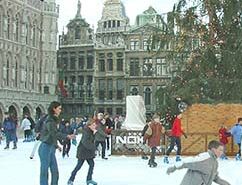
|
CHRISTMAS in BELGIUM
|
ST. NICHOLAS
On the evening of December 6th, St. Nicholas, dressed in his Bishop's
robes, rides about on a horse in Belgium. Children set their shoes at
the fireplace and leave vegetables in them for the horse. In return,
the goodly saint leaves sweets and small gifts in the shoes.
It is said that he rides his white horse on the roofs of the houses
and delivers the gifts via the chimney. In some regions he rides a
little donkey instead of the horse.
|
|
|
Father Christmas
Father Christmas is someone who is altogether different from
St. Nicholas. Children in Belgium were taught to 'believe' in
the existance of St. Nicolas, however Father Christmas is basically
an "import" from the U.S. --- another example of the merchants
hijacking what used to be a religious holiday.
In earlier times, Christmas was a family-celebration with the
focus on the religious character of the holiday. Gift giving was
deferred until New Year's Day. The presents
that the children received came from their parents and not from a
Santa Claus figure. International communications and commerce have
changed the focus of the holiday into a spending spree. Still, it
has its religious overtones and the department stores aren't selling
Christmas decorations in August as is done in the U.S.
Christmas Trees
In recent decades, Christmas trees have become popular in the home
as well as in town squares and shopping areas. After the family
celebration on December 25th, people, both young and old,
flock to the frozen canals or rinks set up in the city for an afternoon
of skating. Here you'll see grandparents skating alongside little
grandchildren who seem to be almost too young to even walk.

Nativity Scenes
The churches in Belgium have beautiful Nativity scenes and they are
quite popular in homes also. Some of the hand-carved figures handed
down from generation to generation are works of great artistic merit.
Nativity plays are still popular in some areas and they are often
performed in 16th century costume; similar to what was worn at the
time the tradition began.
Another tradition continues in small villages where three men
are chosen to portray the three kings. They move from house to
house singing carols and are rewarded with small gifts of food.
Since the food is consumed on the spot, the men are often selected
for their girth as well as their virtue and musical ability.
|
|
